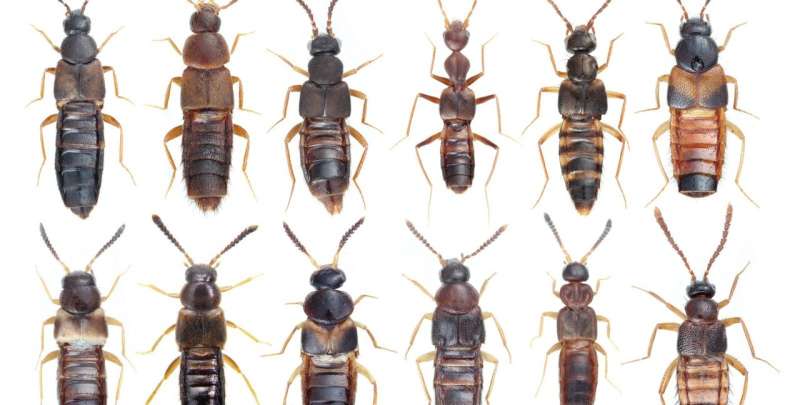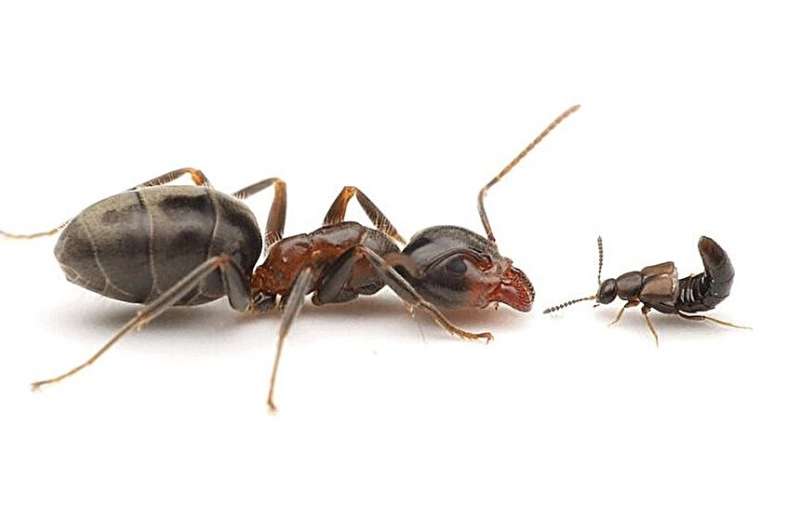This article has been reviewed according to Science X's editorial process and policies. Editors have highlighted the following attributes while ensuring the content's credibility:
fact-checked
peer-reviewed publication
trusted source
proofread
Beetles conquered Earth by evolving their own biochemical laboratory, new study finds

As organisms diversified on planet Earth, some branches of the tree of life became exceptionally diverse, others far less so. Still others went extinct. Why evolution favored certain groups over others is a long-standing question in evolutionary science.
Beetles are the poster child of evolutionary success: about 400,000 species are known—about a quarter of all described lifeforms—and potentially hundreds of thousands more await discovery. The beauty and diversity of beetles enchanted a young Charles Darwin and were the teenage fascination of Alfred Russell Wallace, the co-discoverers of evolution by natural selection.
But why are there so many beetles? One widely held view is that beetles gained an ecological advantage by evolving elytra, the hardened shield-like structures that protect the flight wings, enabling them to live in many different niches that other insects can't access. Another hypothesis is that beetles co-evolved with flowering plants. As these plants diversified, so too did the beetles that feed on them.
Yet, both these ideas fall short in explaining the biggest beetle group of all—the rove beetles (Staphylinidae) a sprawling radiation of over 66,000 species—not just the largest beetle family, but the largest family in the entire animal kingdom. Rove beetles are an enigma: they seem to have both forsaken strongly protective elytra and are mostly predatory instead of feeding on plants. Yet, they exploded across Earth's biosphere, invading every terrestrial niche imaginable over the past 200 million years.
What drove this remarkable success is the focus of a new study by researchers in the laboratory of Joe Parker, assistant professor of biology and biological engineering, Chen Scholar, and director of Caltech's Center for Evolutionary Science. Led by former postdoctoral scholar Sheila Kitchen, the study, appearing online on June 17 in the journal Cell, pinpoints evolution of two cell types that form a chemical defense gland within these beetles' bodies as a catalyst behind their global radiation.
In 2021, researchers in the Parker lab studied a gland in rove beetles called the "tergal gland," a structure at the tip of their flexible abdomens. The team showed how the tergal gland is made up of two unique cell types: one that makes toxic compounds called benzoquinones, and another that makes a liquid mixture (or solvent) into which the benzoquinones dissolve, creating a potent cocktail that the beetle discharges at predators.
In the new work, Kitchen, Parker and their collaborators assembled whole genomes from a diverse set of species spanning the rove beetle evolutionary tree, and analyzed the genes expressed with the gland's two cell types. Doing so enabled them to uncover an ancient genetic toolkit that evolved over 100 million years ago, equipping these insects with their powerful chemical defenses.
"In piecing together the genomes, we were amazed by how similar the genetic architecture of the gland was across this massive group of beetles," says Kitchen, who is now an assistant professor at Texas A&M University. "It was when we started to look at specific gene families, we found hundreds of ancient genes that had found new functions within the gland, and a small but essential set of evolutionarily new genes.
"These new genes were key to rove beetles evolving their amazing chemistry. Telling this story was made possible by our fantastic interdisciplinary team of evolutionary biologists, chemical ecologists, protein biochemists and microscopists."
Retracing the molecular steps in gland evolution, the team identified a major evolutionary innovation in the way the beetles evolved to safely manufacture the poisonous benzoquinones. They found that rove beetles hit upon a mechanism of toxin secretion that is strikingly similar to how plants control the release of chemical compounds that deter herbivores. They bind the toxin to a sugar molecule, rendering it inactive, and then cleave the toxin from the sugar only when the chemical is secreted safely outside of the beetle's own cells.
"It's pretty remarkable that chemically-defended beetles stitched together pretty much the same cellular mechanism as plants for not poisoning themselves with their own nasty chemicals," says Parker.
This mechanism evolved in the Early Cretaceous; after they evolved it, the beetles started to radiate into tens or possibly hundreds of thousands of species. "It's the archetypal key innovation. Once they hit upon this solution, it really took them places, evolutionarily-speaking," Parker says. Related rove beetle lineages that lack the gland have not had the same evolutionary diversification, numbering only tens to hundreds of species.

By exploring the chemistries of different species, the researchers found that, remarkably, while the two cell types comprising the gland have stayed largely the same, the chemicals they produce can evolve dramatically, adapting rove beetles to different ecological niches. The gland can be thought of as a kind of chemical laboratory in which a beetle species can synthesize the compounds needed to live in new environments.
For example, one group of rove beetles evolved to prey on mites and repurposed the gland to secrete mite sex pheromones; another lives inside ant colonies, and produces chemicals that pacify the otherwise highly aggressive worker ants, enabling the beetle to live symbiotically with the ants, and even prey upon them.
"The rove beetle tergal gland is this incredible, reprogrammable device for making new chemistries and evolving new interactions," says Parker. "It enabled these beetles to achieve extreme forms of ecological specialization. Without the gland, there would have been no getting into the weird and wonderful niches that these beetles have found themselves."
Ironically, the team found that in one beetle group, the gland was surplus to requirements. According to Kitchen, "Apparently, once you have lived inside an army ant colony of millions of aggressive ants for long enough, you no longer need the gland.
"We found that beetles that have managed to trick ants into accepting them into their societies had lost their glands during evolution. Their gland toolkit genes had accumulated lots of inactivating mutations. An ant colony is a terrifying place for most species, but for these beetles it's a danger-free fortress—they've conned the ants into protecting them instead."
The new study highlights how evolutionary changes at the cellular level can have major, long-term consequences for ecological and evolutionary diversification. In this case, contributing to nature's inordinate fondness for beetles.
In addition to Kitchen and Parker, Caltech co-authors are graduate students Thomas Naragon, Jean Badroos, Joani Viliunas, Yuriko Kishi, and Julian Wagner (Ph.D. '24); former postdoctoral scholar Adrian Brückner; electron microscopy scientist Mark Ladinsky; former graduate students Sofia Quinodoz (Ph.D. '20) and David Miller (Ph.D. '22); former lab manager Mina Yousefelahiyeh; Director of the Caltech Genomics Facility Igor Antoshechkin; and Professor of Biology Mitch Guttman. Additional co-authors are K. Taro Eldredge of the University of Michigan, Stacy Pirro of Iridian Genomes, Steven Davis of the American Museum of Natural History, and Matthew Aardema of Montclair State University.
More information: Sheila A. Kitchen et al, The genomic and cellular basis of biosynthetic innovation in rove beetles, Cell (2024). DOI: 10.1016/j.cell.2024.05.012
Journal information: Cell
Provided by California Institute of Technology




















